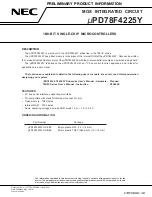
27.6.4. Additional Features
27.6.4.1. Non-Maskable Interrupt (NMI)
The non-maskable interrupt pin can also generate an interrupt on edge or level detection, but it is
configured with the dedicated NMI Control register (NMICTRL). To select the sense for NMI, write to the
NMISENSE bit group in the NMI Control register (NMICTRL.NMISENSE). NMI filtering is enabled by
writing a '1' to the NMI Filter Enable bit (NMICTRL.NMIFILTEN).
If edge detection or filtering is required, enable GCLK_EIC or CLK_ULP32K.
NMI detection is enabled only by the NMICTRL.NMISENSE value, and the EIC is not required to be
enabled.
When an NMI is detected, the non-maskable interrupt flag in the NMI Flag Status and Clear register is set
(NMIFLAG.NMI). NMI interrupt generation is always enabled, and NMIFLAG.NMI generates an interrupt
request when set.
27.6.4.2. Asynchronous Edge Detection Mode
The EXTINT edge detection can be operated synchronously or asynchronously, selected by the
Asynchronous Control Mode bit for external pin x in the External Interrupt Asynchronous Mode register
(
.ASYNCH[x]). The EIC edge detection is operated synchronously when the Asynchronous
Control Mode bit (ASYNCH.ASYNCH[x]) is '0' (default value). It is operated asynchronously when
ASYNCH.ASYNCH[x] is written to '1'.
In
Synchronous Edge Detection Mode
, the external interrupt (EXTINT) or the non-maskable interrupt
(NMI) pins are sampled using the EIC clock as defined by the Clock Selection bit in the Control A register
(
.CKSEL). The External Interrupt flag (INTFLAG.EXTINT[x]) or Non-Maskable Interrupt flag
(NMIFLAG.NMI) is set when the last sampled state of the pin differs from the previously sampled state. In
this mode, the EIC clock is required.
The Synchronous Edge Detection Mode can be used in Idle sleep mode.
In
Asynchronous Edge Detection Mode
, the external interrupt (EXTINT) pins or the non-maskable
interrupt (NMI) pins set the External Interrupt flag or Non-Maskable Interrupt flag (INTFLAG.EXTINT[x] or
NMIFLAG) directly. In this mode, the EIC clock is not requested.
The asynchronous edge detection mode can be used in all sleep modes.
27.6.5. DMA Operation
Not applicable.
27.6.6. Interrupts
The EIC has the following interrupt sources:
•
External interrupt pins (EXTINTx). See
•
Non-maskable interrupt pin (NMI). See
.
Each interrupt source has an associated interrupt flag. The interrupt flag in the Interrupt Flag Status and
Clear register (INTFLAG) is set when an interrupt condition occurs (NMIFLAG for NMI). Each interrupt,
except NMI, can be individually enabled by setting the corresponding bit in the Interrupt Enable Set
register (INTENSET=1), and disabled by setting the corresponding bit in the Interrupt Enable Clear
register (INTENCLR=1).
An interrupt request is generated when the interrupt flag is set and the corresponding interrupt is enabled.
The interrupt request remains active until the interrupt flag is cleared, the interrupt is disabled, or the EIC
is reset. See the INTFLAG register for details on how to clear interrupt flags. The EIC has one common
Atmel SAM L22G / L22J / L22N [DATASHEET]
Atmel-42402E-SAM L22G / L22J / L22N_Datasheet_Complete-07/2016
501
















































